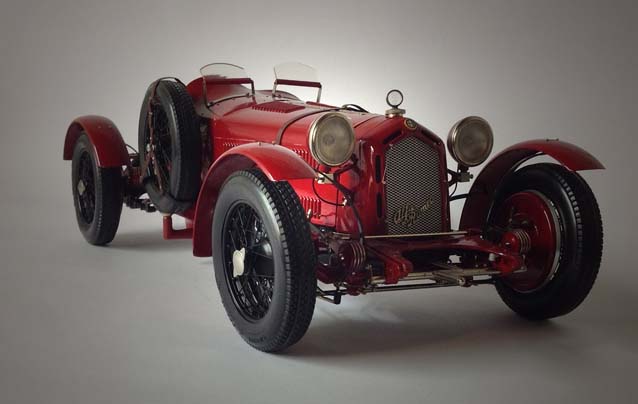Luciano Poli, Italy
Alfa Monza
One of the more cantankerous Pocher kits is the venerable Alfa Romeo Monza, which is a representation of what the Alfa factory originally called the Alfa Romeo 8c 2300 Corsa. The prototype for this model was one of history's most successful race cars, and after eighty-seven years it is still admired as an iconic combination of shape, sound, and proportion. Ask a kindergartener to draw a race car, and odds are the result will resemble the shape and proportions of the Alfa Monza. Countless toy manufacturers have used the shape to thrill their young customers, and scale models of 8c 2300's can be found in most collections of scale model cars in all sizes. All of this adulation and exposure places a certain burden on the builder of the Pocher version. Not only is the prototype familiar, but for some of us, the details are memorized as only the impressionable, childish eye can imprint. Enthusiasts of a certain age may have the howl of the Monza's straight-eight seared into their memories as well, and places like Pebble Beach and Goodwood do their best to keep the legend alive. Living up to such memories and impressions can be a heavy burden for the would-be Pocher builder. It is one thing to build a model of a one-off racing special, and quite another to match the memories of over-excited vintage racing fans.
The Pocher folk have given us a wonderful starting point-correct proportions, plenty of details, and glorious louvers-but it is up to the builder to bring the model to life. What to do, what to do? Worn tires and grubby paint? An unusual color and a shiny engine? Upside down in a ditch, bleeding oil and fuel? Whatever the decision, the builder of a Pocher Monza has to know that someone has already 'been there and done that.' Despite the proliferation of the prototypes-there are more examples around now than were built by the factory-the Pocher builder faces a dilemma of Biblical proportions because the wonderful alternative of 'doing something new' is really not available without venturing into the grotesque or the unlikely. The only alternatives are to rely on the Pocher box top or, horrors of horrors, to rely on actual prototypes. Yikes. Where's the fun in that?
Apparently, Luciano Poli of Italy has faced this decision and has not only survived to tell the tale, but he has managed to accomplish a rare thing: he has built a unique tribute to this famous icon. His careful observation of his subject has resulted in a model that captures the spirit of his subject. Congratulations to him for his accomplishment. It is understandable that the joy that the project gave him is demonstrated by the finished model.

































You must be logged in to post a comment.